Effects of Dietary Potassium Diformate Supplementation on Growth Performance, Nutrient Digestibility, Gastrointestinal pH, Jejunal Morphology, Digestive Enzyme Activity, and Antioxidant Status in Weaned Piglets
Abstract
Simple Summary
Abstract
1. Introduction
2. Materials and Methods
2.1. Experimental Design
2.2. Sample Collection and Analysis
2.2.1. Nutrient Digestibility
2.2.2. Gastrointestinal Digesta pH
2.2.3. Jejunal Morphology
2.2.4. Antioxidant Parameters and Digestive Enzyme Activities in Jejunal Mucosa
2.3. Statistical Analysis
3. Results
3.1. Growth Performance and Nutrient Digestibility
3.2. Gastrointestinal Digesta pH
3.3. Jejunal Morphology
3.4. Antioxidant Status and Digestive Enzyme Activities in Jejunal Mucosa
3.5. Correlation Analysis
4. Discussion
5. Conclusions
Author Contributions
Funding
Institutional Review Board Statement
Informed Consent Statement
Data Availability Statement
Conflicts of Interest
Abbreviations
| ATTD | Apparent total tract digestibility |
| CAT | Catalase |
| CD | Crypt depth |
| FCR | Feed conversion ratio |
| H&E | Hematoxylin and eosin |
| MDA | Malondialdehyde |
| SID | Standardized ileal digestibility |
| T-AOC | Total antioxidant capacity |
| T-SOD | Total superoxide dismutase |
| VH | Villus height |
| VH/CD | Villus height/crypt depth |
References
- Will, K.J.; Magalhaes, E.S.; Moura, C.A.A.; Trevisan, G.; Silva, G.S.; Mellagi, A.P.G.; Ulguim, R.R.; Bortolozzo, F.P.; Linhares, D.C.L. Risk factors associated with piglet pre-weaning mortality in a Midwestern U.S. swine production system from 2020 to 2022. Prev. Vet. Med. 2024, 232, 106316. [Google Scholar] [CrossRef]
- Liu, Z.-X.; Wei, H.-K.; Zhou, Y.-F.; Peng, J. Multi-level mixed models for evaluating factors affecting the mortality and weaning weight of piglets in large-scale commercial farms in central China. Anim. Sci. J. 2018, 89, 760–769. [Google Scholar] [CrossRef]
- René, R.; Sebastian, V.; Marlies, D.; Lukas, S.; Annemarie, K.; Andrea, L. Risk factors associated with post-weaning diarrhoea in Austrian piglet-producing farms. Porc. Health Manag. 2023, 9, 20. [Google Scholar] [CrossRef] [PubMed]
- Huting, A.M.S.; Middelkoop, A.; Guan, X.; Molist, F. Using nutritional strategies to shape the gastro-intestinal tracts of suckling and weaned piglets. Animals 2021, 11, 402. [Google Scholar] [CrossRef] [PubMed]
- Gu, X.; Li, D.; She, R. Effect of weaning on small intestinal structure and function in the piglet. Arch. Anim. Nutr. 2002, 56, 275–286. [Google Scholar] [CrossRef]
- Montagne, L.; Boudry, G.; Favier, C.; Huërou-Luron, I.L.; Lallès, J.-P.; Sève, B. Main intestinal markers associated with the changes in gut architecture and function in piglets after weaning. Br. J. Nutr. 2007, 97, 45–57. [Google Scholar] [CrossRef] [PubMed]
- Shi, Z.; Wang, T.; Kang, J.; Li, Y.; Li, Y.; Xi, L. Effects of weaning modes on the intestinal pH, activity of digestive enzymes, and intestinal morphology of piglets. Animals 2022, 12, 2200. [Google Scholar] [CrossRef]
- Yin, J.; Wu, M.M.; Xiao, H.; Ren, W.K.; Duan, J.L.; Yang, G.; Li, T.J.; Yin, Y.L. Development of an antioxidant system after early weaning in piglets. J. Anim. Sci. 2014, 92, 612–619. [Google Scholar] [CrossRef]
- Wang, M.; Wang, L.; Tan, X.; Wang, L.; Xiong, X.; Wang, Y.; Wang, Q.; Yang, H.; Yin, Y. The developmental changes in intestinal epithelial cell proliferation, differentiation, and shedding in weaning piglets. Anim. Nutr. 2022, 9, 214–222. [Google Scholar] [CrossRef]
- Chen, X.; Zheng, A.; Chen, Z.; Pirzado, S.A.; Wang, Z.; Chen, J.; Zou, Z.; Liu, G. Potassium diformate affects the growth and development of broilers by improving intestinal function and digestive enzyme activity. Poult. Sci. 2024, 103, 104049. [Google Scholar] [CrossRef]
- Chen, J.; He, S.; Zhang, Z.; Li, J.; Zhang, X.; Li, J.; Xu, J.; Zheng, P.; Xian, J.; Lu, Y. Application of organic acid salts as feed additives in some aquatic organisms: Potassium diformate. Fishes 2024, 9, 85. [Google Scholar] [CrossRef]
- Xia, S.; Yao, W.; Zou, B.; Lu, Y.; Lu, N.; Lei, H.; Xia, D. Effects of potassium diformate on the gastric function of weaning piglets. Anim. Prod. Sci. 2016, 56, 1161–1166. [Google Scholar] [CrossRef]
- Chowdhury, R.; Haque, M.N.; Islam, K.M.S.; Khan, M.J. Potassium diformate: A new alternative to antibiotic growth promoters. Bangladesh J. Anim. Sci. 2012, 37, 99–105. [Google Scholar] [CrossRef]
- Lin, Y.; Zhai, J.-L.; Wang, Y.-T.; Guo, P.-T.; Zhang, J.; Wang, C.-K.; Jin, L.; Gao, Y.-Y. Potassium diformate alleviated inflammation of IPEC-J2 cells infected with EHEC. Vet. Microbiol. 2024, 291, 110013. [Google Scholar] [CrossRef] [PubMed]
- Windisch, W.M.; Gotterbarm, G.G.; Roth, F.X. Effect of potassium diformate in combination with different amounts and sources of excessive dietary copper on production performance in weaning piglets. Arch. Anim. Nutr. 2001, 54, 87–100. [Google Scholar] [CrossRef]
- Zhou, Y.; Wei, X.; Zi, Z.; Zou, B.; Xia, S.; Lu, N.; Lei, H.; Lu, Y.; Parvizi, N.; Xia, D. Potassium diformate influences gene expression of GH/IGF-I axis and glucose homeostasis in weaning piglets. Livest. Sci. 2015, 172, 85–90. [Google Scholar] [CrossRef]
- Htoo, J.K.; Molares, J. Effects of dietary supplementation with two potassium formate sources on performance of 8- to 22-kg pigs. J. Anim. Sci. 2012, 90, 346–349. [Google Scholar] [CrossRef]
- Poeikhampha, T.; Bunchasak, C. Comparative effects of sodium gluconate, mannan oligosaccharide and potassium diformate on growth performances and small intestinal morphology of nursery pigs. Asian Australas. J. Anim. Sci. 2011, 24, 844–850. [Google Scholar] [CrossRef]
- Taube, V.A.; Neu, M.E.; Hassan, Y.; Verspohl, J.; Beyerbach, M.; Kamphues, J. Effects of dietary additives (potassium diformate/organic acids) as well as influences of grinding intensity (coarse/fine) of diets for weaned piglets experimentally infected with Salmonella Derby or Escherichia coli. J. Anim. Physiol. Anim. Nutr. 2009, 93, 350–358. [Google Scholar] [CrossRef]
- Papenbrock, S.; Stemme, K.; Amtsberg, G.; Verspohl, J.; Kamphues, J. Investigations on prophylactic effects of coarse feed structure and/or potassium diformate on the microflora in the digestive tract of weaned piglets experimentally infected with Salmonella Derby. J. Anim. Physiol. Anim. Nutr. 2005, 89, 84–87. [Google Scholar] [CrossRef]
- Canibe, N.; Steien, S.H.; Øverland, M.; Jensen, B.B. Effect of K-diformate in starter diets on acidity, microbiota, and the amount of organic acids in the digestive tract of piglets, and on gastric alterations. J. Anim. Sci. 2001, 79, 2123–2133. [Google Scholar] [CrossRef] [PubMed]
- National Research Council (NRC). Nutrient Requirements of Swine; National Academies Press: Washington, DC, USA, 2012. [Google Scholar]
- Mesonero Escuredo, J.A.; van der Horst, Y.; Carr, J.; Maes, D. Implementing drinking water feed additive strategies in post-weaning piglets, antibiotic reduction and performance impacts: Case study. Porc. Health Manag. 2016, 2, 25. [Google Scholar] [CrossRef] [PubMed]
- Prawirodigdo, S.; Gannon, N.J.; Leury, B.J.; Dunshea, F.R. Acid-insoluble ash is a better indigestible marker than chromic oxide to measure apparent total tract digestibility in pigs. Anim. Nutr. 2021, 7, 64–71. [Google Scholar] [CrossRef] [PubMed]
- AOAC. Official Methods of Analysis, 16th ed.; AOAC International: Washington, DC, USA, 1995. [Google Scholar]
- Zhou, W.; Zhong, H.; Huang, Z.; Han, J.; Yang, Z.; Zou, T.; You, J.; Chen, J. Dietary organic selenium supplementation for weaned piglets challenged with deoxynivalenol. Animals 2025, 15, 2546. [Google Scholar] [CrossRef]
- Chen, J.; Jia, X.; Hu, Y.; Zhao, X.; Cheng, Y.; Lu, L.; Zhong, S.; You, J.; Zou, T. Benzoic acid as a dietary supplement mitigates inflammation and intestinal injury in acute enterotoxigenic Escherichia coli-infected mice without adverse effects in healthy mice. Food Funct. 2025, 16, 3195–3210. [Google Scholar] [CrossRef]
- Fan, P.; Liu, P.; Song, P.; Chen, X.; Ma, X. Moderate dietary protein restriction alters the composition of gut microbiota and improves ileal barrier function in adult pig model. Sci. Rep. 2017, 7, 43412. [Google Scholar] [CrossRef]
- Chang, S.Y.; Lee, J.H.; Oh, H.J.; An, J.W.; Song, D.C.; Cho, H.A.; Park, S.H.; Jeon, K.H.; Cho, S.Y.; Kim, D.J.; et al. Effect of different ratios of phytogenic feed additives on growth performance, nutrient digestibility, intestinal barrier integrity, and immune response in weaned pigs challenged with a pathogenic Escherichia coli. J. Anim. Sci. 2023, 101, skad148. [Google Scholar] [CrossRef]
- Zeebone, Y.Y.; Kovács, M.; Bóta, B.; Zdeněk, V.; Taubner, T.; Halas, V. Dietary fumonisin may compromise the nutritive value of feed and distort copper and zinc digestibility and retention in weaned piglets. J. Anim. Physiol. Anim. Nutr. 2023, 107, 504–517. [Google Scholar] [CrossRef]
- Øverland, M.; Bikker, P.; Fledderus, J. Potassium diformate in the diet of reproducing sows: Effect on performance of sows and litters. Livest. Sci. 2009, 122, 241–247. [Google Scholar] [CrossRef]
- Paulicks, B.R.; Roth, F.X.; Kirchgessner, M. Effects of potassium diformate (Formi® LHS) in combination with different grains and energy densities in the feed on growth performance of weaned piglets. J. Anim. Physiol. Anim. Nutr. 2000, 84, 102–111. [Google Scholar] [CrossRef]
- Mroz, Z.; Reese, D.E.; Øverland, M.; van Diepen, J.T.M.; Kogut, J. The effects of potassium diformate and its molecular constituents on the apparent ileal and fecal digestibility and retention of nutrients in growing-finishing pigs. J. Anim. Sci. 2002, 80, 681–690. [Google Scholar] [CrossRef] [PubMed]
- Cranwell, P.D. The development of acid and pepsin (EC 3. 4. 23. 1) secretory capacity in the pig; the effects of age and weaning: 1. Studies in anaesthetized pigs. Br. J. Nutr. 1985, 54, 305–320. [Google Scholar] [CrossRef] [PubMed]
- Luise, D.; Correa, F.; Bosi, P.; Trevisi, P. A review of the effect of formic acid and its salts on the gastrointestinal microbiota and performance of pigs. Animals 2020, 10, 887. [Google Scholar] [CrossRef] [PubMed]
- Abd El-Hack, M.E.; El-Saadony, M.T.; Salem, H.M.; El-Tahan, A.M.; Soliman, M.M.; Youssef, G.B.A.; Taha, A.E.; Soliman, S.M.; Ahmed, A.E.; El-kott, A.F.; et al. Alternatives to antibiotics for organic poultry production: Types, modes of action and impacts on bird’s health and production. Poult. Sci. 2022, 101, 101696. [Google Scholar] [CrossRef]
- Kim, S.W.; Duarte, M.E. Understanding intestinal health in nursery pigs and the relevant nutritional strategies. Anim. Biosci. 2021, 34, 338–344. [Google Scholar] [CrossRef]
- Fouhse, J.M.; Dawson, K.; Graugnard, D.; Dyck, M.; Willing, B.P. Dietary supplementation of weaned piglets with a yeast-derived mannan-rich fraction modulates cecal microbial profiles, jejunal morphology and gene expression. Animal 2019, 13, 1591–1598. [Google Scholar] [CrossRef]
- Pieszka, M.; Szczepanik, K.; Orczewska-Dudek, S.; Kamyczek, M.; Śliwiński, B.; Gala, Ł.; Pieszka, M. The effect of a supplement of potassium formate and/or probiotic to the feed on the protection of piglets gastrointestinal tract against the negative effects of pathogenic bacteria. Livest. Sci. 2025, 292, 105637. [Google Scholar] [CrossRef]
- Zhang, G.G.; Yang, Z.B.; Wang, Y.; Yang, W.R.; Zhou, H.J. Effects of dietary supplementation of multi-enzyme on growth performance, nutrient digestibility, small intestinal digestive enzyme activities, and large intestinal selected microbiota in weanling pigs. J. Anim. Sci. 2014, 92, 2063–2069. [Google Scholar] [CrossRef]
- Ma, J.; Long, S.; Wang, J.; Gao, J.; Piao, X. Microencapsulated essential oils combined with organic acids improves immune antioxidant capacity and intestinal barrier function as well as modulates the hindgut microbial community in piglets. J. Anim. Sci. Biotechnol. 2022, 13, 16. [Google Scholar] [CrossRef]
- Xu, Y.T.; Liu, L.; Long, S.F.; Pan, L.; Piao, X.S. Effect of organic acids and essential oils on performance, intestinal health and digestive enzyme activities of weaned pigs. Anim. Feed Sci. Technol. 2018, 235, 110–119. [Google Scholar] [CrossRef]
- Guo, S.; Chu, H.; Peng, B.; Niu, J.; Yang, X.; Guo, Y.; Wang, Z.; Zhang, W. Effects of lactic acid and glyceryl lactate on growth performance, antioxidant capacity, and intestinal health of piglets. Antioxidants 2025, 14, 391. [Google Scholar] [CrossRef]
- Cai, L.; Zhao, Y.; Chen, W.; Li, Y.; Han, Y.; Zhang, B.; Pineda, L.; Li, X.; Jiang, X. Effect of an organic acid blend as an antibiotic alternative on growth performance, antioxidant capacity, intestinal barrier function, and fecal microbiota in weaned piglets. J. Anim. Sci. 2024, 102, skae149. [Google Scholar] [CrossRef]
- Li, Z.; Liu, S.; Zhao, Y.; Wang, J.; Ma, X. Compound organic acid could improve the growth performance, immunity and antioxidant properties, and intestinal health by altering the microbiota profile of weaned piglets. J. Anim. Sci. 2023, 101, skad196. [Google Scholar] [CrossRef]
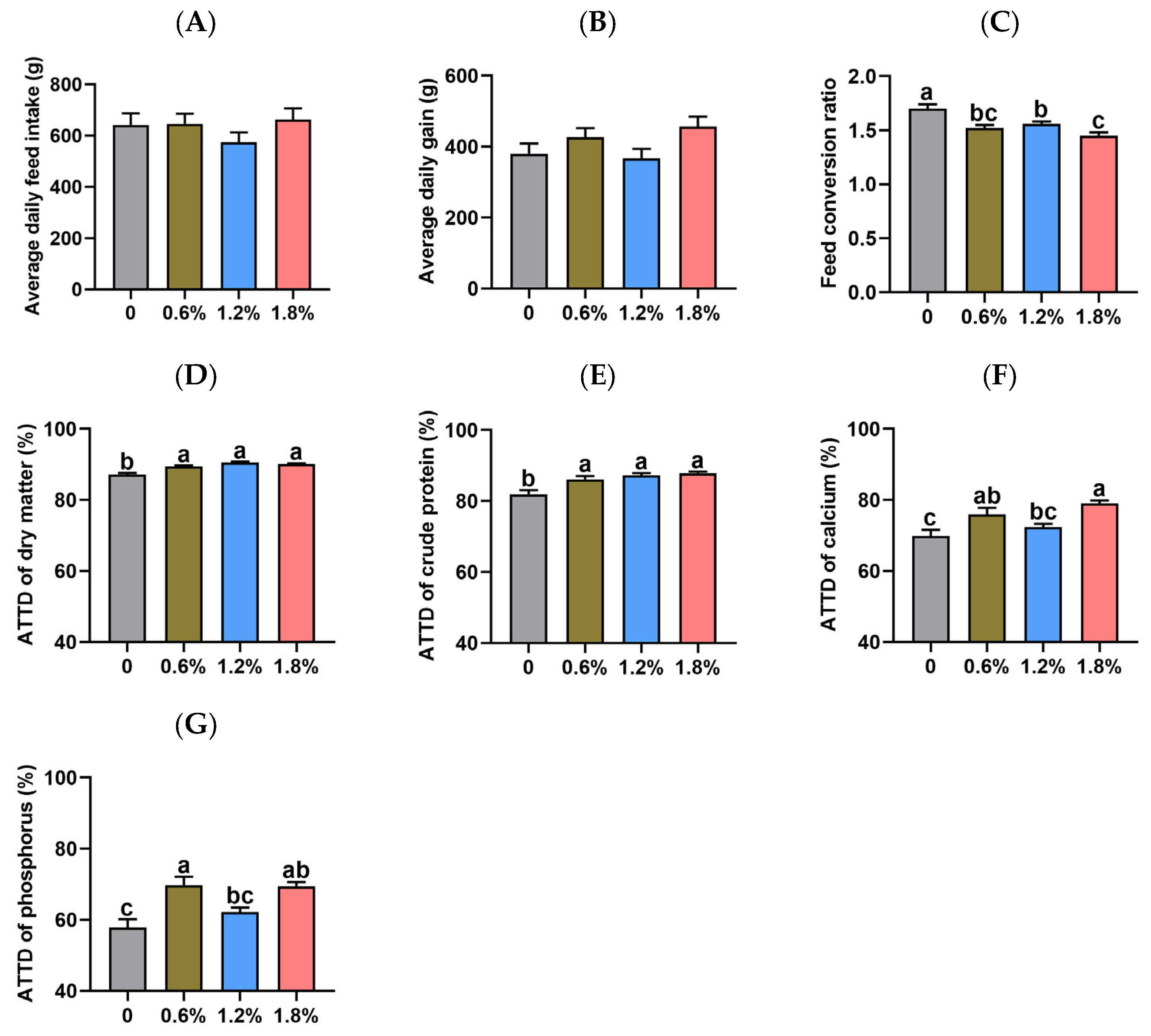
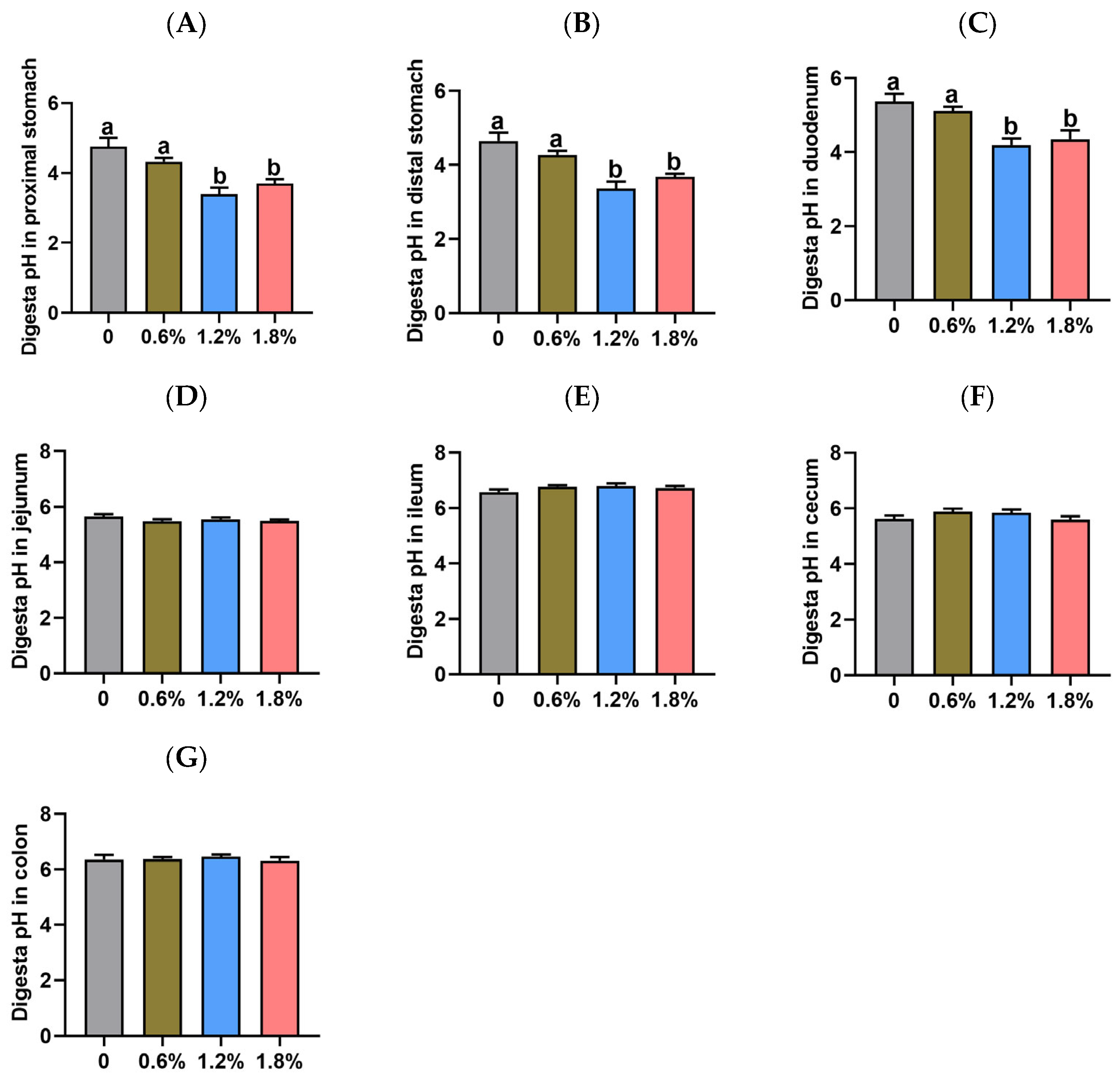
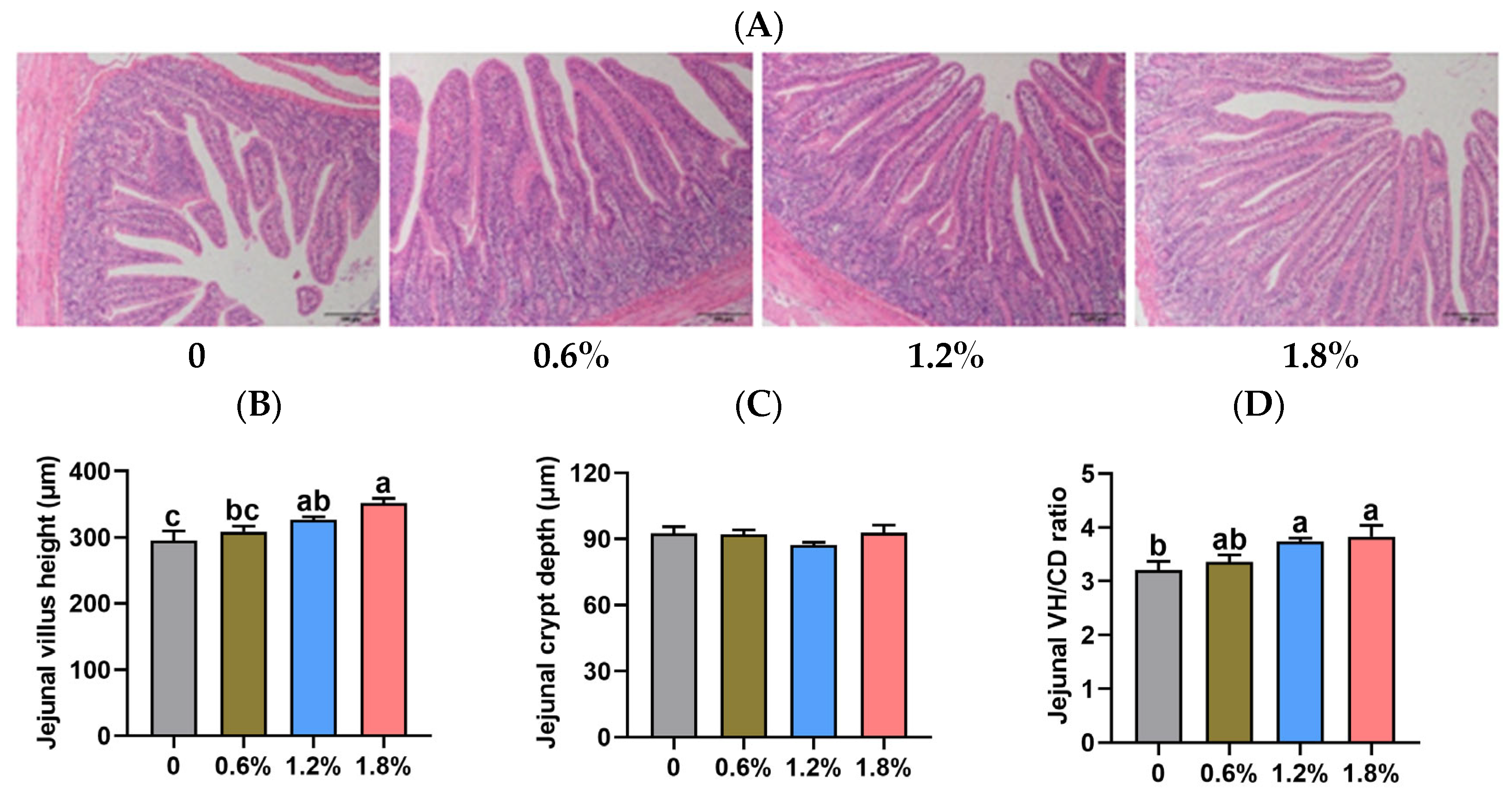
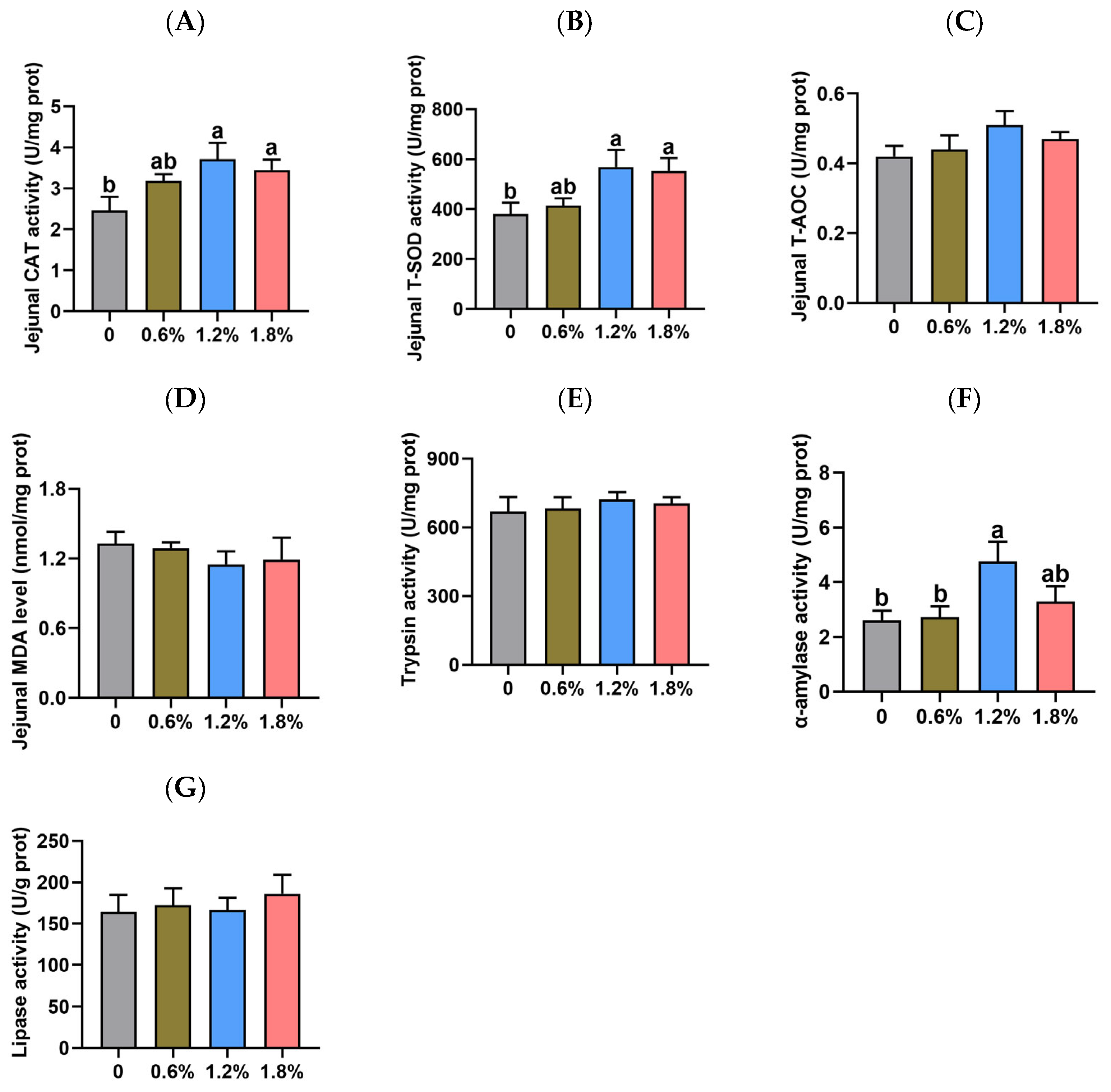
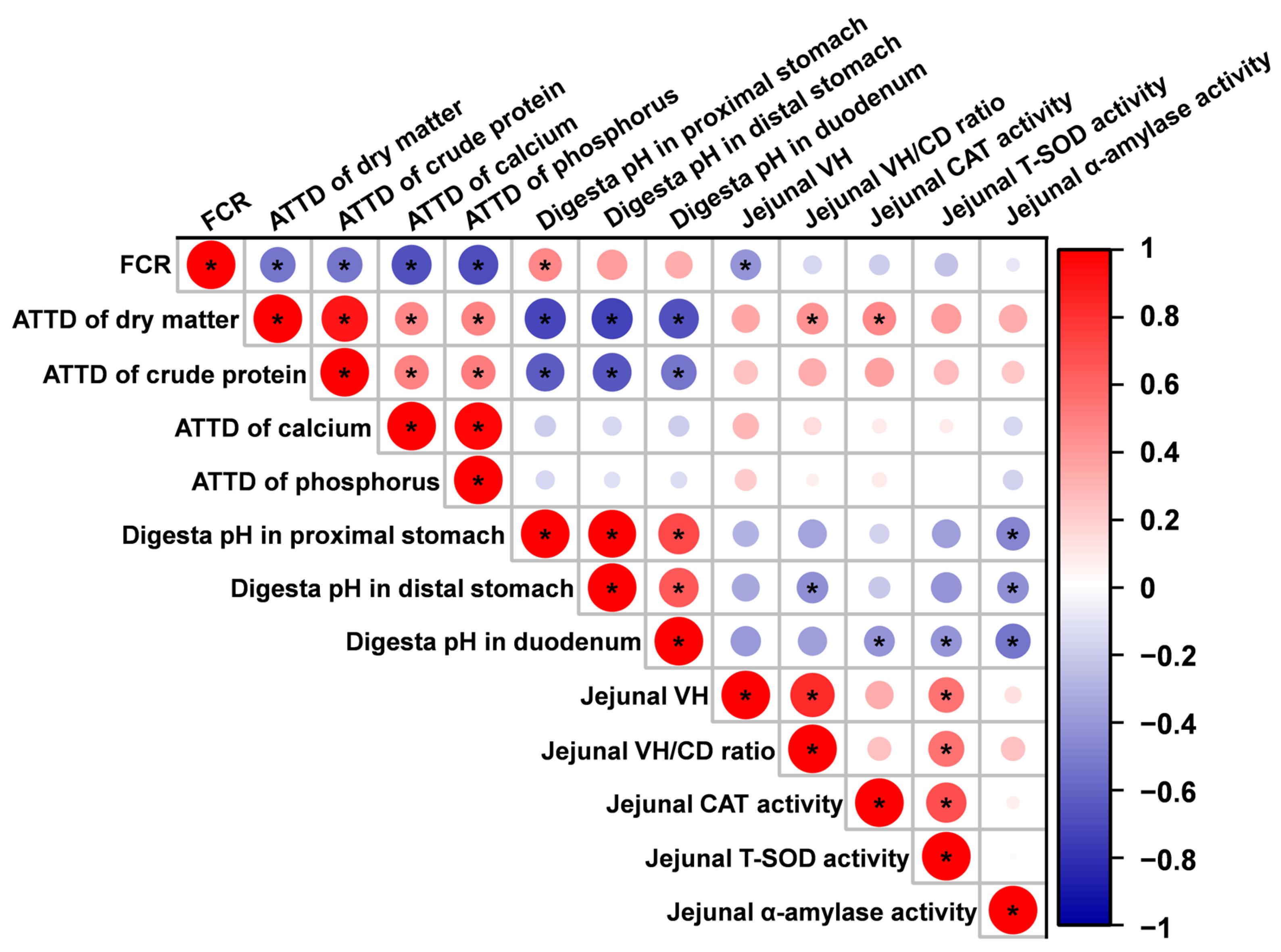
| Ingredient | Content (%) | Nutrient | Content |
|---|---|---|---|
| Corn | 27.78 | Digestible energy, MJ/kg 2 | 14.79 |
| Expanded corn | 35.00 | Crude protein, % 3 | 17.71 |
| Soybean meal | 8.00 | Organic matter, % 3 | 83.57 |
| Extruded soybean | 10.00 | Calcium, % 3 | 0.81 |
| Whey powder | 4.00 | Total phosphorus, % 3 | 0.62 |
| Fish meal | 2.00 | Available phosphorus, % 2 | 0.45 |
| Soybean protein concentrate | 5.00 | SID Lysine, % 2 | 1.54 |
| Soybean oil | 3.00 | SID Methionine, % 2 | 0.45 |
| Premix 1 | 5.22 | SID Threonine, % 2 | 0.97 |
| Total | 100.00 | SID Tryptophan, % 2 | 0.28 |
| Items | Basal Diet | 0.6% Potassium Diformate-Supplemented Diet | 1.2% Potassium Diformate-Supplemented Diet | 1.8% Potassium Diformate-Supplemented Diet |
|---|---|---|---|---|
| Potassium diformate level | 0 | 0.6% | 1.2% | 1.8% |
| Zeolite level | 1.8% | 1.2% | 0.6% | 0 |
| Total 1 | 1.8% | 1.8% | 1.8% | 1.8% |
Disclaimer/Publisher’s Note: The statements, opinions and data contained in all publications are solely those of the individual author(s) and contributor(s) and not of MDPI and/or the editor(s). MDPI and/or the editor(s) disclaim responsibility for any injury to people or property resulting from any ideas, methods, instructions or products referred to in the content. |
© 2025 by the authors. Licensee MDPI, Basel, Switzerland. This article is an open access article distributed under the terms and conditions of the Creative Commons Attribution (CC BY) license (https://creativecommons.org/licenses/by/4.0/).
Share and Cite
Zhang, L.; Cheng, Y.; Lu, L.; Zhong, S.; Zou, T.; Qu, M.; Chen, J. Effects of Dietary Potassium Diformate Supplementation on Growth Performance, Nutrient Digestibility, Gastrointestinal pH, Jejunal Morphology, Digestive Enzyme Activity, and Antioxidant Status in Weaned Piglets. Animals 2025, 15, 2916. https://doi.org/10.3390/ani15192916
Zhang L, Cheng Y, Lu L, Zhong S, Zou T, Qu M, Chen J. Effects of Dietary Potassium Diformate Supplementation on Growth Performance, Nutrient Digestibility, Gastrointestinal pH, Jejunal Morphology, Digestive Enzyme Activity, and Antioxidant Status in Weaned Piglets. Animals. 2025; 15(19):2916. https://doi.org/10.3390/ani15192916
Chicago/Turabian StyleZhang, Lina, Yong Cheng, Li Lu, Songtao Zhong, Tiande Zou, Mingren Qu, and Jun Chen. 2025. "Effects of Dietary Potassium Diformate Supplementation on Growth Performance, Nutrient Digestibility, Gastrointestinal pH, Jejunal Morphology, Digestive Enzyme Activity, and Antioxidant Status in Weaned Piglets" Animals 15, no. 19: 2916. https://doi.org/10.3390/ani15192916
APA StyleZhang, L., Cheng, Y., Lu, L., Zhong, S., Zou, T., Qu, M., & Chen, J. (2025). Effects of Dietary Potassium Diformate Supplementation on Growth Performance, Nutrient Digestibility, Gastrointestinal pH, Jejunal Morphology, Digestive Enzyme Activity, and Antioxidant Status in Weaned Piglets. Animals, 15(19), 2916. https://doi.org/10.3390/ani15192916






